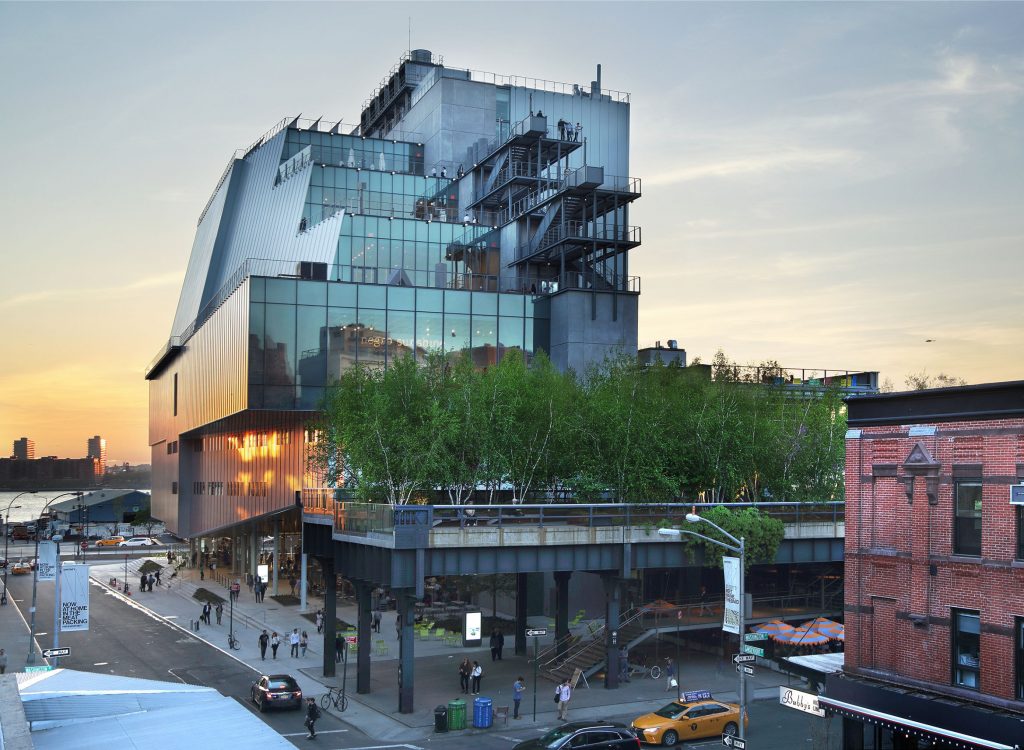The Whitney Museum of American Art in Manhattan revolutionizes its neighborhood with social life, freedom and accessibility. Located in Greenwich village on the Hudson River, the new Whitney building, designed by Renzo Piano, is just a few blocks from its original location. Since its inauguration on May 1st, 2015, the building has attracted a host of audiences with an appreciation for art. The museum houses contemporary American art, focusing on artists of the current generation, especially since the founder of the Whitney, Gertrude Vanderbilt Whitney, was an artist herself. The new space allowed the collection to expand from 2,000 works to over 20,000 pieces, providing an area that artists can work with and incorporate into their material.
Renzo Piano, a renowned architect, was selected to design the new building after a series of attempts by the museum board to maximize space at the old location. Interestingly, all the architects that were considered for the job were asked what their favorite building was, and they all chose one designed by Piano. When creating the design, Renzo had an ambitious goal to blend social life, urbanity, invention, construction, technology, poetry and light. Amazingly, Renzo succeeded in fulfilling each category.
Born in Italy, Piano believes that America is a place of opportunities; it is due to this that Renzo blends his European traditionalism with the freedom of American art. The building has a sense of continuity with its 360° design and no specific frontal view.
The ground floor resembles a piazza that buzzes with social life, emphasizing openness and accessibility. Even the artists are given a sense of freedom as they are able to use the galleries not just as show rooms, but also as vital aspects of their exhibits. The many terraces can be used for projections, installations, sculptures, and almost anything an artist can imagine. These terraces are especially unique and exciting to visitors as they offer a breathtaking view of New York City and the Hudson River.
Today, there are a few exhibitions in the Whitney Museum. The four main elevators that take museum-goers up to the galleries are art in themselves. Designed by Richard Artshwager, they are the only permanent artwork commissioned for the site. The art at the Whitney comes to you and engulfs you during your ride, making for a truly engaging museum experience.
On the fifth floor, the first of the five experimental exhibitions called Open Plan is on display. The entire fifth floor is bare with white walls and floor to ceiling windows on opposite ends of the huge, 18,200 square foot room. Walking into the breathtaking space, visitors’ ears are filled with the sounds of a jail. Andrea Fraser, an installation and performance artist, was the first artist of the five exhibitions. Fraser explores the dynamic possibilities of a free, innovative and public art museum contrasted with the sounds of an actual jail only thirty two miles away.
The other fifth floor exhibit, Down the River, attempts to emphasize the consequences of an increasingly polarized society by highlighting divisions in race, class and geography. Overall, the fifth floor is astonishing, especially when the sunlight filters into the room during the day.
On the eighth floor, Laura Poitras’s exhibition, Astro Noise is on display. Poitras is an artist, filmmaker, and journalist who specializes in discussing the complex realities of the post 9/11 world.
At the entrance of the exhibit, the viewer enters a dark room with projections. One of these is particularly moving, as it reveals the facial expressions of the people New York City witnessing the 9/11 attack. The film tells the story of these horrible events in an engaging way that connects to viewers emotionally, physically, and intellectually.
Around the corner, the viewer enters another dark room with a projection of a starry night on the ceiling. Once viewers adjust their eyes, they will be surprised to find a mass of bodies lying next to each other on a raised structure, gazing up at the entrancing projection. Little do the star gazers know that in the next room, others are watching an infrared recording of their bodies. Uniquely, Poitras succeeds in engaging the viewer to not only understand, but feel the large and historical global forces that are current today.
Everyone with an appreciation for contemporary art should pay a visit to the new Whitney Museum. Because it is located at the end of the Manhattan High Line, museum patrons can enjoy a beautiful walk, surrounded by the rooftops of the city and iconic Manhattan vistas. With endless views and inspiration, located in one of the city’s most vibrant and unique neighborhoods, the museum is great for connecting to society and the city. Perfect for families and people of all ages, the Whitney Museum is an icon of modern American culture.
Lena Yannella
reporter

